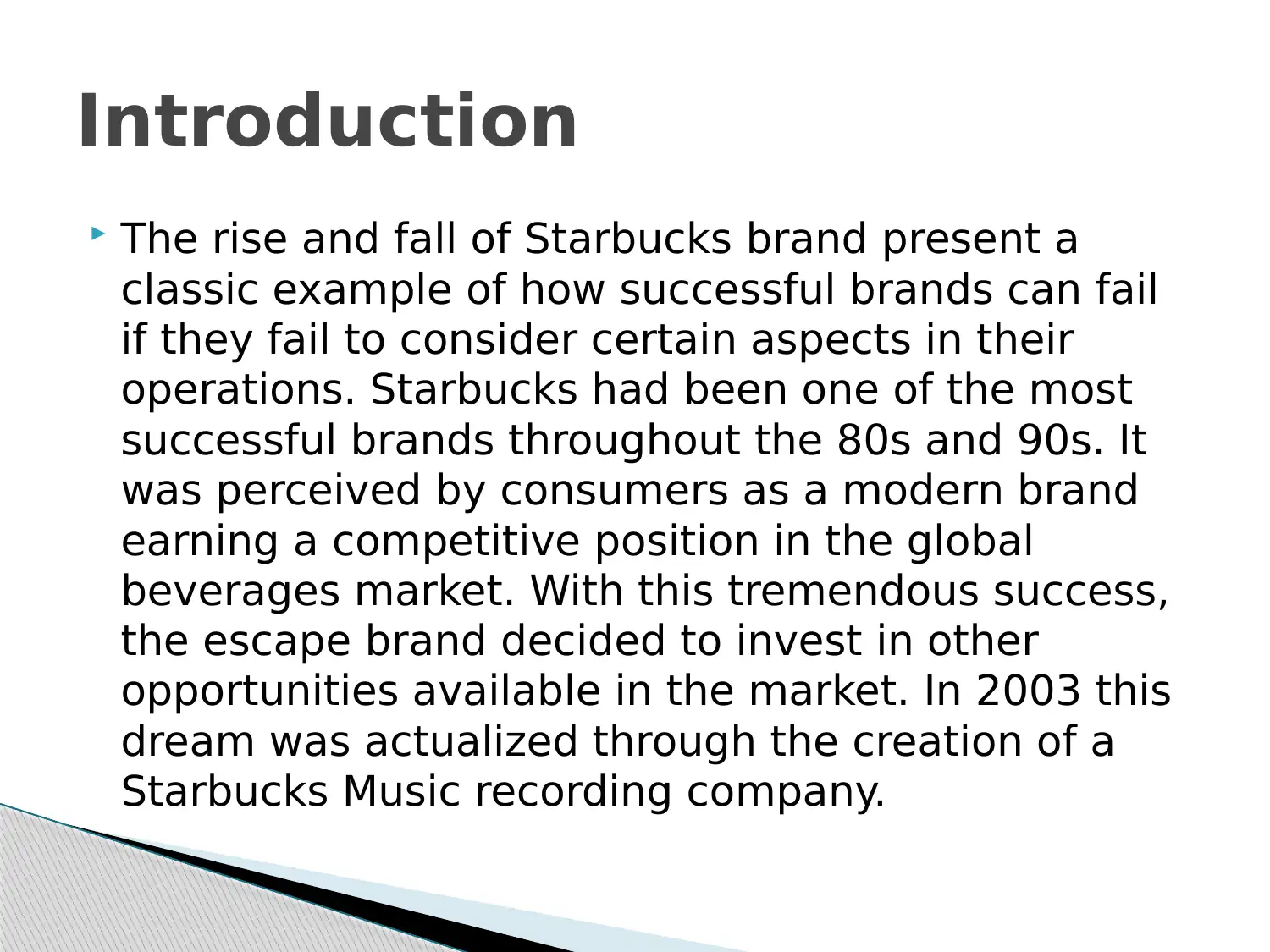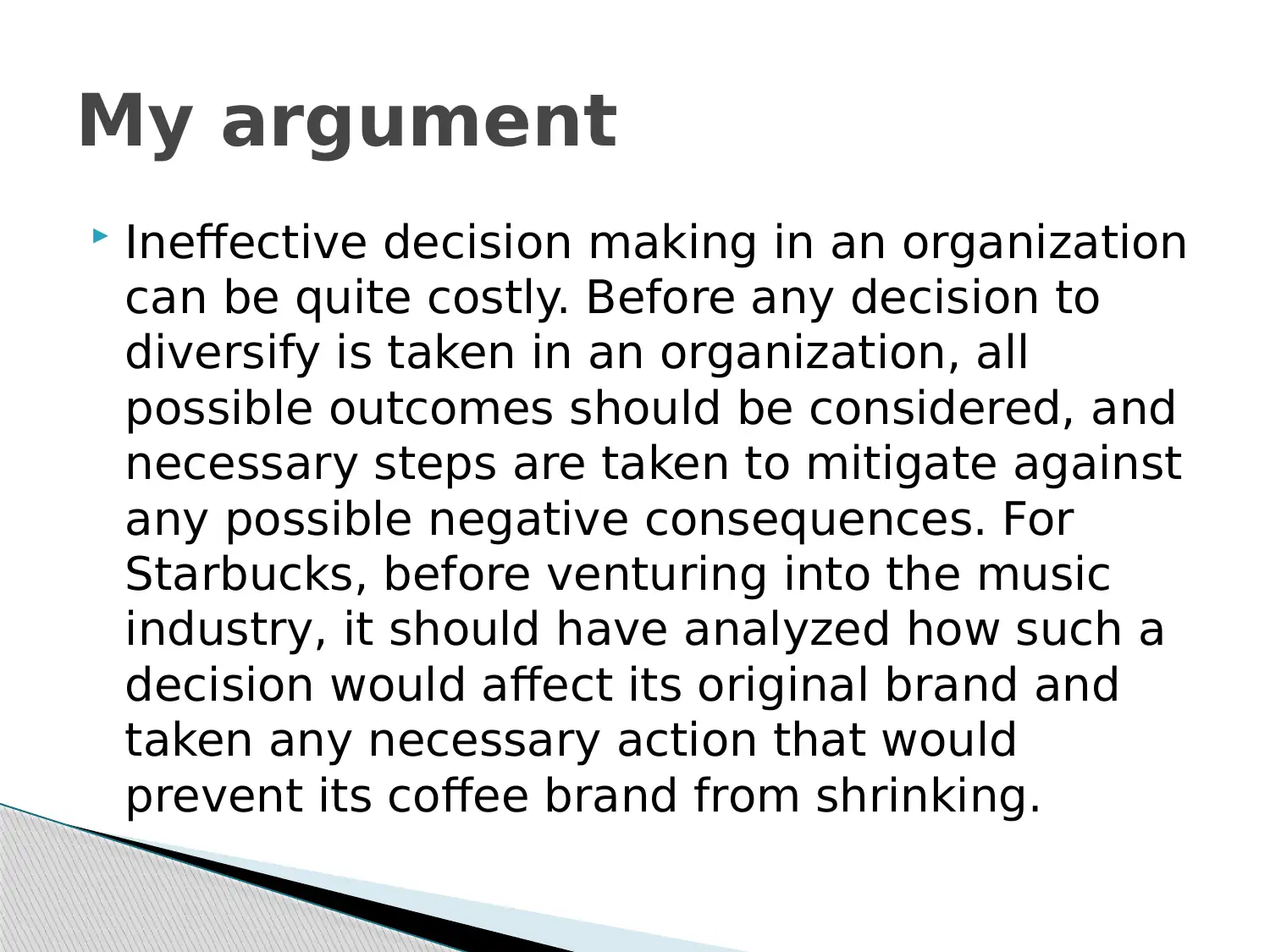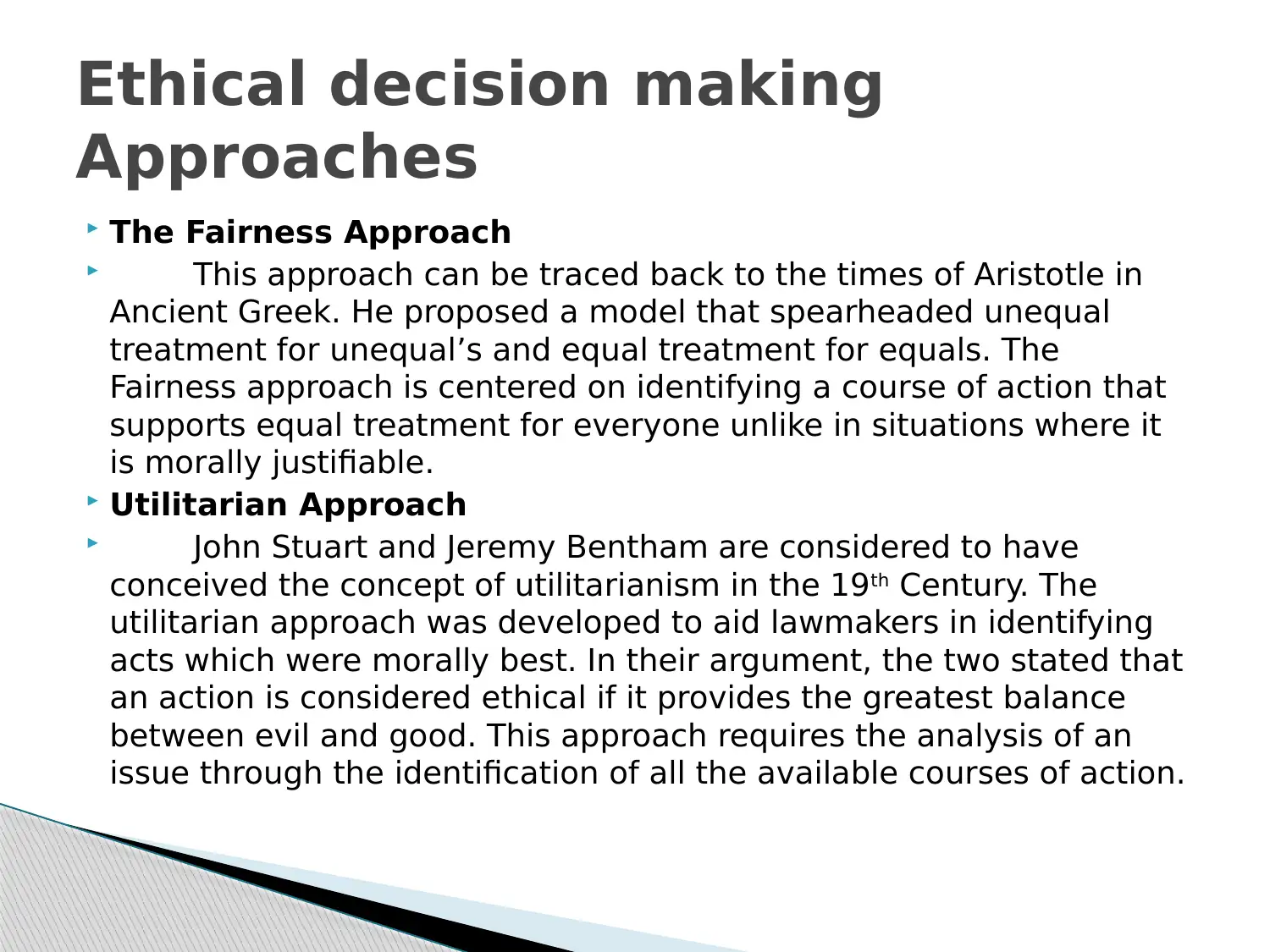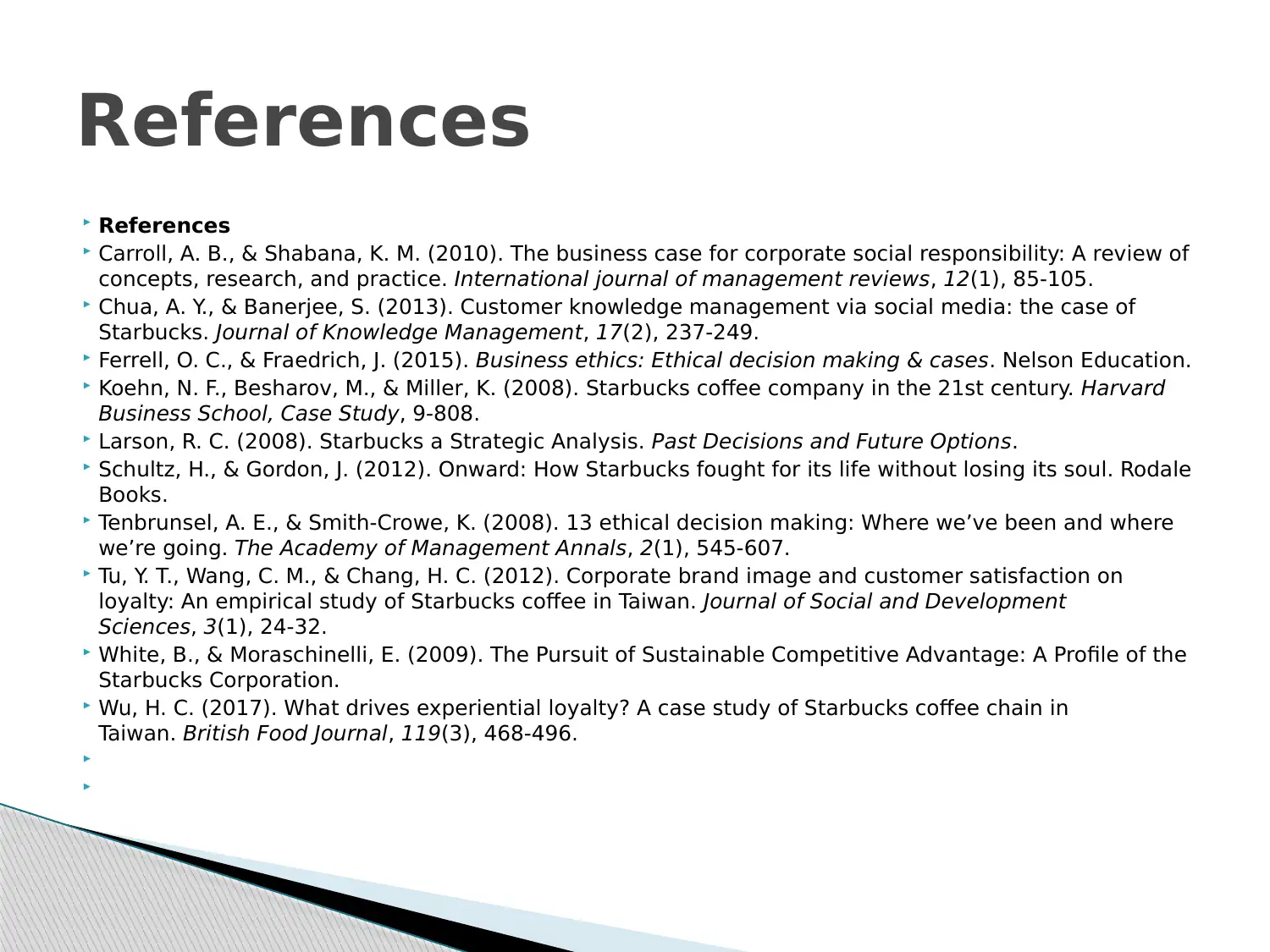BUS3003: Starbucks Case Study on Corporate Responsibility and Ethics
VerifiedAdded on 2023/06/07
|7
|852
|365
Case Study
AI Summary
This case study analyzes the rise and fall of the Starbucks brand, highlighting how diversification into the music industry impacted its core coffee business. It discusses the company's history, expansion strategies, and the importance of ethical decision-making. The study emphasizes the need for organizations to carefully consider potential consequences before diversifying, using ethical frameworks like the Fairness Approach and Utilitarian Approach to evaluate decisions. The case draws upon various academic resources to examine Starbucks' corporate responsibility, customer knowledge management, and the pursuit of sustainable competitive advantage, providing a comprehensive overview of the challenges and considerations involved in corporate diversification and ethical governance.

Paraphrase This Document
Need a fresh take? Get an instant paraphrase of this document with our AI Paraphraser

The rise and fall of Starbucks brand present a
classic example of how successful brands can fail
if they fail to consider certain aspects in their
operations. Starbucks had been one of the most
successful brands throughout the 80s and 90s. It
was perceived by consumers as a modern brand
earning a competitive position in the global
beverages market. With this tremendous success,
the escape brand decided to invest in other
opportunities available in the market. In 2003 this
dream was actualized through the creation of a
Starbucks Music recording company.
Introduction
classic example of how successful brands can fail
if they fail to consider certain aspects in their
operations. Starbucks had been one of the most
successful brands throughout the 80s and 90s. It
was perceived by consumers as a modern brand
earning a competitive position in the global
beverages market. With this tremendous success,
the escape brand decided to invest in other
opportunities available in the market. In 2003 this
dream was actualized through the creation of a
Starbucks Music recording company.
Introduction

Starbucks is an American Coffee company
founded by Zev Siegel, Jewry Baldwin and
Gordon Bowker in 1971. The Multinational
Corporation has its headquarters in Washington
Dc. The coffee chain has maintained it global
position ruling the coffee industry for decades,
with its global stores currently estimated at
28218. The Company entry in the early 1990's
came as a major boost for an organization that
had become profitable almost nine years after it
was started.
Brief History
founded by Zev Siegel, Jewry Baldwin and
Gordon Bowker in 1971. The Multinational
Corporation has its headquarters in Washington
Dc. The coffee chain has maintained it global
position ruling the coffee industry for decades,
with its global stores currently estimated at
28218. The Company entry in the early 1990's
came as a major boost for an organization that
had become profitable almost nine years after it
was started.
Brief History
⊘ This is a preview!⊘
Do you want full access?
Subscribe today to unlock all pages.

Trusted by 1+ million students worldwide

Organizations adopt different strategies to
expand their operations and improve their
profit margins. Diversification and
internalization are the most commonly used
strategies. Diversification is a strategy used by
organizations to enter into new industries or
markets. Diversification involves exploration of
new markets and the creation of new products
or services suitable for those new markets.
Diversification can provide a good opportunity
for an organization to achieve stability.
Discussion of the case
expand their operations and improve their
profit margins. Diversification and
internalization are the most commonly used
strategies. Diversification is a strategy used by
organizations to enter into new industries or
markets. Diversification involves exploration of
new markets and the creation of new products
or services suitable for those new markets.
Diversification can provide a good opportunity
for an organization to achieve stability.
Discussion of the case
Paraphrase This Document
Need a fresh take? Get an instant paraphrase of this document with our AI Paraphraser

Ineffective decision making in an organization
can be quite costly. Before any decision to
diversify is taken in an organization, all
possible outcomes should be considered, and
necessary steps are taken to mitigate against
any possible negative consequences. For
Starbucks, before venturing into the music
industry, it should have analyzed how such a
decision would affect its original brand and
taken any necessary action that would
prevent its coffee brand from shrinking.
My argument
can be quite costly. Before any decision to
diversify is taken in an organization, all
possible outcomes should be considered, and
necessary steps are taken to mitigate against
any possible negative consequences. For
Starbucks, before venturing into the music
industry, it should have analyzed how such a
decision would affect its original brand and
taken any necessary action that would
prevent its coffee brand from shrinking.
My argument

The Fairness Approach
This approach can be traced back to the times of Aristotle in
Ancient Greek. He proposed a model that spearheaded unequal
treatment for unequal’s and equal treatment for equals. The
Fairness approach is centered on identifying a course of action that
supports equal treatment for everyone unlike in situations where it
is morally justifiable.
Utilitarian Approach
John Stuart and Jeremy Bentham are considered to have
conceived the concept of utilitarianism in the 19th Century. The
utilitarian approach was developed to aid lawmakers in identifying
acts which were morally best. In their argument, the two stated that
an action is considered ethical if it provides the greatest balance
between evil and good. This approach requires the analysis of an
issue through the identification of all the available courses of action.
Ethical decision making
Approaches
This approach can be traced back to the times of Aristotle in
Ancient Greek. He proposed a model that spearheaded unequal
treatment for unequal’s and equal treatment for equals. The
Fairness approach is centered on identifying a course of action that
supports equal treatment for everyone unlike in situations where it
is morally justifiable.
Utilitarian Approach
John Stuart and Jeremy Bentham are considered to have
conceived the concept of utilitarianism in the 19th Century. The
utilitarian approach was developed to aid lawmakers in identifying
acts which were morally best. In their argument, the two stated that
an action is considered ethical if it provides the greatest balance
between evil and good. This approach requires the analysis of an
issue through the identification of all the available courses of action.
Ethical decision making
Approaches
⊘ This is a preview!⊘
Do you want full access?
Subscribe today to unlock all pages.

Trusted by 1+ million students worldwide

References
Carroll, A. B., & Shabana, K. M. (2010). The business case for corporate social responsibility: A review of
concepts, research, and practice. International journal of management reviews, 12(1), 85-105.
Chua, A. Y., & Banerjee, S. (2013). Customer knowledge management via social media: the case of
Starbucks. Journal of Knowledge Management, 17(2), 237-249.
Ferrell, O. C., & Fraedrich, J. (2015). Business ethics: Ethical decision making & cases. Nelson Education.
Koehn, N. F., Besharov, M., & Miller, K. (2008). Starbucks coffee company in the 21st century. Harvard
Business School, Case Study, 9-808.
Larson, R. C. (2008). Starbucks a Strategic Analysis. Past Decisions and Future Options.
Schultz, H., & Gordon, J. (2012). Onward: How Starbucks fought for its life without losing its soul. Rodale
Books.
Tenbrunsel, A. E., & Smith‐Crowe, K. (2008). 13 ethical decision making: Where we’ve been and where
we’re going. The Academy of Management Annals, 2(1), 545-607.
Tu, Y. T., Wang, C. M., & Chang, H. C. (2012). Corporate brand image and customer satisfaction on
loyalty: An empirical study of Starbucks coffee in Taiwan. Journal of Social and Development
Sciences, 3(1), 24-32.
White, B., & Moraschinelli, E. (2009). The Pursuit of Sustainable Competitive Advantage: A Profile of the
Starbucks Corporation.
Wu, H. C. (2017). What drives experiential loyalty? A case study of Starbucks coffee chain in
Taiwan. British Food Journal, 119(3), 468-496.
References
Carroll, A. B., & Shabana, K. M. (2010). The business case for corporate social responsibility: A review of
concepts, research, and practice. International journal of management reviews, 12(1), 85-105.
Chua, A. Y., & Banerjee, S. (2013). Customer knowledge management via social media: the case of
Starbucks. Journal of Knowledge Management, 17(2), 237-249.
Ferrell, O. C., & Fraedrich, J. (2015). Business ethics: Ethical decision making & cases. Nelson Education.
Koehn, N. F., Besharov, M., & Miller, K. (2008). Starbucks coffee company in the 21st century. Harvard
Business School, Case Study, 9-808.
Larson, R. C. (2008). Starbucks a Strategic Analysis. Past Decisions and Future Options.
Schultz, H., & Gordon, J. (2012). Onward: How Starbucks fought for its life without losing its soul. Rodale
Books.
Tenbrunsel, A. E., & Smith‐Crowe, K. (2008). 13 ethical decision making: Where we’ve been and where
we’re going. The Academy of Management Annals, 2(1), 545-607.
Tu, Y. T., Wang, C. M., & Chang, H. C. (2012). Corporate brand image and customer satisfaction on
loyalty: An empirical study of Starbucks coffee in Taiwan. Journal of Social and Development
Sciences, 3(1), 24-32.
White, B., & Moraschinelli, E. (2009). The Pursuit of Sustainable Competitive Advantage: A Profile of the
Starbucks Corporation.
Wu, H. C. (2017). What drives experiential loyalty? A case study of Starbucks coffee chain in
Taiwan. British Food Journal, 119(3), 468-496.
References
1 out of 7
Related Documents
Your All-in-One AI-Powered Toolkit for Academic Success.
+13062052269
info@desklib.com
Available 24*7 on WhatsApp / Email
![[object Object]](/_next/static/media/star-bottom.7253800d.svg)
Unlock your academic potential
Copyright © 2020–2025 A2Z Services. All Rights Reserved. Developed and managed by ZUCOL.





